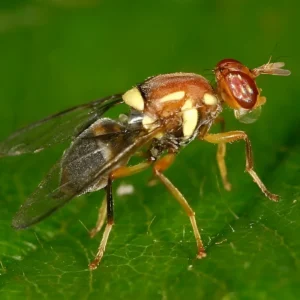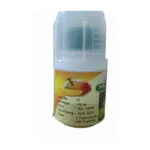Acid Lime Pests
FruitFly

Symptoms
Fruit Damage:
- Puncture Marks: Tiny puncture marks on the fruit's skin indicate where the female fly laid eggs. These marks are often difficult to see but can be visible as small dark spots.
- Fruit Rot and Softening: As larvae feed, the fruit starts to soften and rot from the inside out, often leading to premature fruit drop.
- Larval Tunnels: When the fruit is cut open, the presence of larval tunnels and maggots inside is a clear sign of fruit fly infestation.
- Secondary Infections: Feeding damage often allows pathogens to enter the fruit, leading to further decay and spoilage.
Yield Loss:
- Reduced Marketability: Infested fruit is unsellable due to the presence of maggots and decay, leading to economic losses for growers.
- Premature Fruit Drop: Infested fruits often drop prematurely, further reducing yield.
Identification
Adult Fruit Flies:
- Appearance: Adult fruit flies are small, about 4-5 mm in length, with a yellow-brown or black body. They have distinctive markings on their wings, which can help in species identification. The Mediterranean fruit fly, for example, has a banded pattern on its wings.
- Behavior: Adults are active during warm weather and are often seen hovering around fruit. They are most active in the early morning and late afternoon.
Eggs:
- Appearance: Eggs are small, white, and usually laid just under the skin of the fruit. Each female can lay several hundred eggs during her lifetime.
- Behavior: Eggs hatch into larvae (maggots) within a few days, depending on environmental conditions.
Larvae (Maggots):
- Appearance: The larvae are legless, creamy-white maggots that can grow up to 8 mm in length. They have pointed heads and rounded, segmented bodies.
- Behavior: Larvae feed on the fruit's flesh, creating tunnels and causing the fruit to decay. This feeding damage can lead to secondary infections by fungi and bacteria.
Pupae:
- Appearance: After completing the larval stage, fruit fly larvae drop to the ground and burrow into the soil to pupate. Pupae are brown and oval, resembling small capsules.
- Behavior: The pupal stage lasts for about 1-2 weeks, after which adult flies emerge to begin the cycle again.
Management
- Fruit Bagging: Use protective bags to cover fruits as they develop, preventing fruit flies from laying eggs on them. This method is labor-intensive but effective for small-scale operations.
- Mass Trapping: Use traps baited with attractants such as protein hydrolysate, methyl eugenol, or specific pheromones to lure and capture adult fruit flies. Yellow sticky traps or baited traps can be effective in reducing adult populations.
- Bait Sprays: Use bait sprays containing attractants and insecticides like Spinosad or Malathion. These sprays attract and kill adult fruit flies when they feed on the bait.
- Cover Sprays: In areas with high fruit fly pressure, apply insecticides to the foliage and developing fruits to kill adult flies and reduce egg-laying. It’s essential to follow local regulations and use insecticides that are effective and safe for the environment.
|
Insecticide |
Dosage |
|---|---|
|
0.3 ml/lit |
|
|
2 ml/lit |
|
₹400
Select options
This product has multiple variants. The options may be chosen on the product page
₹400
Select options
This product has multiple variants. The options may be chosen on the product page


